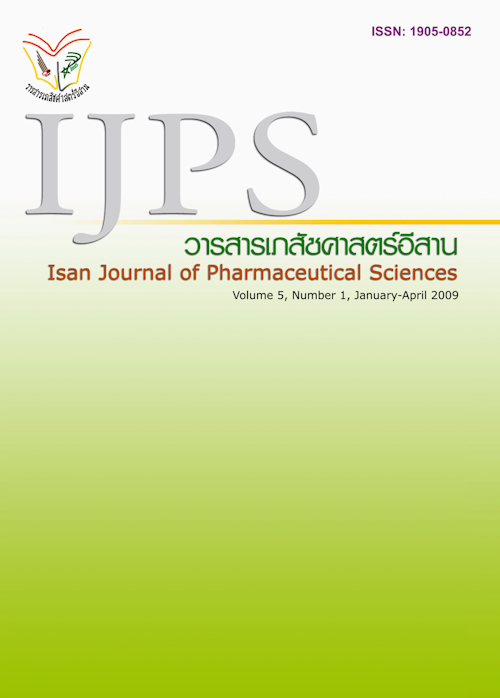Acute Toxicity and Sub-acute Toxicity of Pseuderanthemun palatiferum (Nees) Radlk. Leaf Extract
Main Article Content
Abstract
Pseuderanthemum palatiferum (Nees) Radlk. is a medicinal plant from the Acanthaceae family. This plant has been introduced for to treatment of many diseases including hypertension, diarrhea, arthritis, nephritis, and diabetes. However, there is no scientific data on in its toxicity. The present study aims to assess the toxicity of an 80% ethanol extract of P. palatiferum leaf both in vitro and in vivo. In vitro, the 80% ethanol extract of P. palatiferum was tested in vero cells (african green monkey kidney) by a green fluorescent protein (GFP) - based assay. No cytotoxicity was detected at the dose of 50 µg/mL, which was the highest dose that could be prepared. In vivo, the 80% ethanol extract was administered once orally to adult Wistar rats in various doses (500, 1000, 1500 and 2000 mg/kg). The results showed that no doses of extract produced any signs or symptoms of toxicity during the first 24 hrs and no rat died with in 14 days. Moreover, the body weight of control and treatment groups were not different. A longer acute toxicity was tested on Wistar rats in various doses of 250, 500 and 1000 mg/kg by daily oral administration for 14 days. None of the dose levels showed show any signs or symptoms of toxicity and no rat died. Compared to the control group, the clinical chemistry values such as creatinine, albumin, total protein, triglycerides, and total cholesterol in each groups were not different, except BUN was significantly lower than the doses of 500 and 1000 mg/kg (p < 0.05). The alkaline phosphatase in the dose of 250 mg/kg was significantly lower than the dose of 500 mg/kg (p < 0.05). The gain in body weight of all treated groups were significantly higher than the control group (p < 0.05).
Article Details
In the case that some parts are used by others The author must Confirm that obtaining permission to use some of the original authors. And must attach evidence That the permission has been included
References
Chan PK and Hayes AW. Acute toxicity and eyeirritation. In Hayes AW editor. Principles andmethods of toxicology. New York: RavenPress; 1994. p.579-647.
Collins LA, Torrero MN, Franzblau SG. Greenfluorescent protein reporter micro plate assayfor high-throughput screening of compoundsagainst Mycobacterium tuberculosis. Anti AgenChem 1998; 42: p.344-347.
Dieu HK and Hoa TV. Efficacy of Pseuderanthemumpalatiferum powder against diarrhea of piglet. Cantho: Cantho University; 2003. p.1-6.
Dieu HK, Loc CB, Yamasaki S, et al. 2005. Theethnobotanical and botanical study on Pseuderanthemum palatiferum as a newmedicinal plant in the Mekong Delta of Vietnam. Japa Agri Res Qua 2005; 39(3): p.191-196.
Dieu HK, Loc CB, Yamasaki S, et al. The effects of Pseuderanthemum palatiferum, a newmedicinal plant, on growth performances anddiarrhea of piglets. Japa Agri Res Qua 2006; 40(1): p.85-91.
Froscio S, Cannon E, Humpage A. Research reportNo 66: Optimisation of cylindrospermopsintoxicity assay. Adelaide: Australian WaterQuality Centre; 2008. p.9-10.
Giang PM, Bao HV, Son PT. Study on anti-oxydativeactivities and preliminary investigation onantibacterial, antifungal of extracted fraction richin flavonoides from leaves of Pseuderanthemumpalatiferum (Nees) Radlk. TC khoa hoc va congnghe 2005; 9: p.9-12.
Hung NV, Tuan LA, Chien NQ. Study on chemicalconstituents of Pseuderanthemum palatiferum(Nees) Radlk. TC khoa hoc va cong nghe2004; 42: p.75-79.


